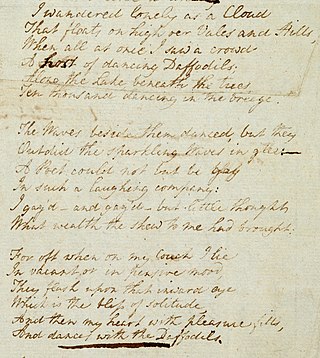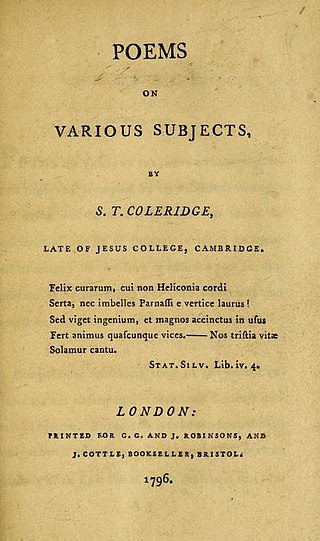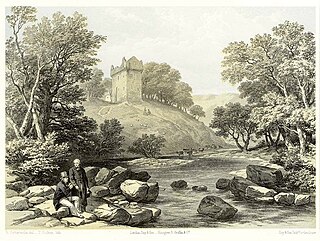
Peter Bell: A Tale in Verse is a long narrative poem by William Wordsworth, written in 1798, but not published until 1819.

Peter Bell: A Tale in Verse is a long narrative poem by William Wordsworth, written in 1798, but not published until 1819.
In a tone of straight-faced humour [1] the prologue tells of the poet's travels over the face of the earth and through the heavens in a boat of the imagination, which urges him to choose some exotic or otherworldly theme. The poet rejects the suggestion and opts for the more homely subject of Peter Bell. The poem proper begins with a description of him as a hard-hearted sinner, impervious to the softening influence of nature, who makes his living as an itinerant hawker (or potter, in Wordsworth's northern expression) of earthenware. One night, while walking through Swaledale by night, he loses his way. He comes across an ass standing untended, gazing into the river Swale, and he tries to ride away on it, but the ass does not respond to his furious beating of it. Peter sees the face of a corpse in the river, and faints from shock. On recovering consciousness, he drags the dead man, once the owner of the ass, onto dry land. The ass now consents to start for home, taking Peter with him. A loud cry is heard in the distance, which, though Peter does not know it, comes from the dead man's young son, who is searching for his father. Unnerved by this, and by the sight of the bloody wounds he has inflicted on the ass, Peter begins to feel unaccustomed pangs of conscience. His mind turns to his many past sins, and as he passes an outdoor Methodist meeting his heart responds to the preacher's calls for repentance. The ass reaches the home of the dead man, whose wife is waiting for him. She learns that she is a widow, and her children orphans:
And now is Peter taught to feel
That man's heart is a holy thing;
And Nature, through a world of death,
Breathes into him a second breath,
More searching than the breath of spring. [2]
The poem closes with Peter downcast by his experiences, but eventually emerging as a better man.

In 1793, while walking in the Wye Valley, Wordsworth fell in with a "wild rover" who, as he later recalled, "told me strange stories" as they wandered together. Five years later he drew on his memories of this vagrant for a new poem. [3] Wordsworth began writing Peter Bell on 20 April 1798, and by late May of that year was able to read it aloud at Alfoxden to William Hazlitt. Though the poem was first written during the final preparations for his and Coleridge's Lyrical Ballads Wordsworth did not choose to include it in that collection. [4] In February 1799 he reported that he had been performing some cuts on Peter Bell. In February 1802 he revised it again, and the following month talked of publishing it, perhaps with "The Ruined Cottage" or "Adventures on Salisbury Plain", but for the moment nothing came of this. [5] [6] One more revision in 1812 was followed by plans for publication in 1815, again abandoned. [7] Peter Bell was finally published in April 1819, with four sonnets to accompany it, and with a dedication to his friend Robert Southey. [8] [9]
John Hamilton Reynolds, reading about the impending publication, wrote a Wordsworth parody called Peter Bell: a Lyrical Ballad, which appeared a week before the genuine Peter Bell and stirred up enough public interest to ensure that Wordsworth's poem went into a second edition within a fortnight. [10] In contemporary journals the poem was, like his previous publications, generally greeted with derision and contempt, critics being especially provoked by the deliberately flat diction and by the mundanity of its subject, as exemplified in Peter Bell's own prosaic name. [11] [7] Leigh Hunt, writing in The Examiner , condemned Peter Bell as "a didactic little horror…founded on the bewitching principles of fear, bigotry, and diseased impulse". [12] Other reviewers spoke of its "gross perversion of intellect" and "tincture of imbecility", and pronounced it "superlatively silly", "daudling, impotent drivel" and "of all Mr. Wordsworth's poems…decidedly the worst". [13] Byron, in his Don Juan , sneered that Wordsworth "makes / Another outcry for 'a little boat', / And drivels seas to set it well afloat". [14]
Even close friends could offer little comfort. Charles Lamb wrote to Wordsworth that though he liked the poem's subject "I cannot say that the style of it quite satisfies me. It is too lyrical," and he privately said that he thought it one of the worst of Wordsworth's works. [15] [16] Henry Crabb Robinson feared Wordsworth had "set himself back ten years by the publication of this unfortunate work". [17] In the months after the publication of Wordsworth's poem and Reynolds' skit a whole rash of Wordsworth parodies broke out, by Keats and Shelley among others. [18] Wordsworth responded to this general damnation of Peter Bell by revising it when he included it in his 1820 collected edition, Miscellaneous Poems, though he also wrote a sonnet "On the Detraction which followed the Publication of a certain Poem" in which he told Peter "Heed not such onset!". [19] [20] Opinion was slow to change in Peter Bell’s favour. In 1879 Matthew Arnold counted it among the poems which only a true Wordsworthian such as himself could read with pleasure, and in 1891 Oscar Wilde cited it as an example of the deleterious influence of Nature on Wordsworth's poetry. [21] [22] Modern Wordsworth critics generally rank Peter Bell high among its author's works, full credit being given to its daring as a "radical experiment". [23] Duncan Wu numbered it among Wordsworth's greatest poems, while Mary Moorman called it "his most brilliant narrative poem". [24] [25]
style of it quite satisfies.

William Wordsworth was an English Romantic poet who, with Samuel Taylor Coleridge, helped to launch the Romantic Age in English literature with their joint publication Lyrical Ballads (1798).

"I Wandered Lonely as a Cloud" is a lyric poem by William Wordsworth. It is one of his most popular, and was inspired by a forest encounter on 15 April 1802 that included himself, his younger sister Dorothy and a "long belt" of daffodils. Written in 1804, this 24 line lyric was first published in 1807 in Poems, in Two Volumes, and slightly revised in 1815.

"The Idiot Boy" is a poem written by William Wordsworth, a representative of the Romantic movement in English literature. The poem was composed in spring 1798 and first published in the same year in Lyrical Ballads, a collection of poems written by Wordsworth and Samuel Taylor Coleridge, which is considered to be a turning point in the history of English literature and the Romantic movement. The poem investigates such themes as language, intellectual disability, maternity, emotionality, organisation of experience and "transgression of the natural."
Nationality words link to articles with information on the nation's poetry or literature.
Events from the year 1798 in Great Britain.

"Ode: Intimations of Immortality from Recollections of Early Childhood" is a poem by William Wordsworth, completed in 1804 and published in Poems, in Two Volumes (1807). The poem was completed in two parts, with the first four stanzas written among a series of poems composed in 1802 about childhood. The first part of the poem was completed on 27 March 1802 and a copy was provided to Wordsworth's friend and fellow poet, Samuel Taylor Coleridge, who responded with his own poem, "Dejection: An Ode", in April. The fourth stanza of the ode ends with a question, and Wordsworth was finally able to answer it with seven additional stanzas completed in early 1804. It was first printed as "Ode" in 1807, and it was not until 1815 that it was edited and reworked to the version that is currently known, "Ode: Intimations of Immortality".

The Lucy poems are a series of five poems composed by the English Romantic poet William Wordsworth (1770–1850) between 1798 and 1801. All but one were first published during 1800 in the second edition of Lyrical Ballads, a collaboration between Wordsworth and Samuel Taylor Coleridge that was both Wordsworth's first major publication and a milestone in the early English Romantic movement. In the series, Wordsworth sought to write unaffected English verse infused with abstract ideals of beauty, nature, love, longing, and death.
William Wordsworth was an English Romantic poet who, with Samuel Taylor Coleridge, helped launch the Romantic Age in English literature with their 1798 joint publication, Lyrical Ballads. His early years were dominated by his experience of the countryside around the Lake District and the English moors. Dorothy Wordsworth, his sister, served as his early companion until their mother's death and their separation when he was sent to school.
The "Matthew" poems are a series of poems, composed by the English Romantic poet William Wordsworth, that describe the character Matthew in Wordsworth's poetry.
"We are Seven" is a poem written by William Wordsworth and published in his Lyrical Ballads. It describes a discussion between an adult poetic speaker and a "little cottage girl" about the number of brothers and sisters who dwell with her. The poem turns on the question of whether to account two dead siblings as part of the family.
"Lucy Gray" is a poem written by William Wordsworth in 1799 and published in his Lyrical Ballads. It describes the death of a young girl named Lucy Gray, who went out one evening into a storm.

"I travelled among unknown men" is a love poem completed in April 1801 by the English poet William Wordsworth and originally intended for the Lyrical Ballads anthology, but it was first published in Poems, in Two Volumes in 1807. The third poem of Wordsworth's "Lucy series", "I travelled..." was composed after the poet had spent time living in Germany in 1798. Due to acute homesickness, the lyrics promise that once returned to England, he will never live abroad again. The poet states he now loves England "more and more". Wordsworth realizes that he did not know how much he loved England until he lived abroad and uses this insight as an analogy to understand his unrequited feelings for his beloved, Lucy.
"A slumber did my spirit seal" is a poem that was written by William Wordsworth in 1798 and first published in volume II of the 1800 edition of Lyrical Ballads. It is part of a series of poems written about a mysterious woman named Lucy, whom scholars have not been able to identify and are not sure whether she was real or fictional. Although the name Lucy is not directly mentioned in the poem, scholars nevertheless believe it to be part of the "Lucy poems" due to the poem's placement in Lyrical Ballads.

"Poor Susan" is a lyric poem by William Wordsworth composed at Alfoxden in 1797. It was first published in the collection Lyrical Ballads in 1798. It is written in anapestic tetrameter.

The White Doe of Rylstone; or, The Fate of the Nortons is a long narrative poem by William Wordsworth, written initially in 1807–08, but not finally revised and published until 1815. It is set during the Rising of the North in 1569 and combines historical and legendary subject-matter. It has attracted praise from some critics, but has never been one of Wordsworth's more popular poems.

Romanticism was an artistic, literary, and intellectual movement that originated in Europe toward the end of the 18th century. Scholars regard the publishing of William Wordsworth's and Samuel Coleridge's Lyrical Ballads in 1798 as probably the beginning of the movement in England, and the crowning of Queen Victoria in 1837 as its end. Romanticism arrived in other parts of the English-speaking world later; in the United States, it arrived around 1820.

Thomas Poole was a Somerset tanner, Radical philanthropist, and essayist, who used his wealth to improve the lives of the poor of Nether Stowey, his native village. He was a friend of several writers in the British Romantic movement, a benefactor of Samuel Taylor Coleridge and his family, and an influence on the poems of Wordsworth.

Allan Bank is a grade II listed two-storey villa standing on high ground slightly to the west of Grasmere village in the heart of the Lake District. It is best known for being from 1808 to 1811 the home of William Wordsworth, but it was also occupied at various times by Dorothy Wordsworth, Dora Wordsworth, Thomas De Quincey, Samuel Taylor Coleridge, Thomas Arnold, Matthew Arnold and Canon Hardwicke Rawnsley. It is now owned by the National Trust and is open to the public.

Poems on Various Subjects (1796) was the first collection by Samuel Taylor Coleridge, including also a few sonnets by Charles Lamb. A second edition in 1797 added many more poems by Lamb and by Charles Lloyd, and a third edition appeared in 1803 with Coleridge's works only. All three editions included poems in Coleridge's early Miltonic style, such as his Religious Musings and Monody on the Death of Chatterton, alongside lyrics and some of his first conversation poems, such as The Eolian Harp, in a style suggested by the works of William Cowper. The book was on the whole well received by reviewers; modern critics value it more for its shorter and lighter poems than for its formal set-pieces.

The Yarrow poems are a series of three poems composed by the English Romantic poet William Wordsworth comprising "Yarrow Unvisited" (1803), "Yarrow Visited" (1814) and "Yarrow Revisited" (1831). "Yarrow Unvisited" presents a justification for his failure to take a detour to see the Yarrow Water, a river much celebrated in earlier Scottish verse, during a tour of Scotland with his sister Dorothy; this, according to the poem, allowed him to retain his imagined idea of the river rather than be disappointed by the reality. It was partly written for his friend Walter Scott, whose friendship with him began during this same tour. The second poem records his impressions on finally seeing the Yarrow in company with the poet James Hogg. The third, a tribute to his friend Walter Scott, was inspired by the poets' last visit to the Yarrow the year before Scott's death. All three draw on the rich heritage of earlier poems and ballads set in the Yarrow Valley. "Yarrow Unvisited" is one of Wordsworth's most famous short poems, and has been judged one of his finest. Modern critical evaluation of the two later works has been more mixed.
pinion wordsworth.